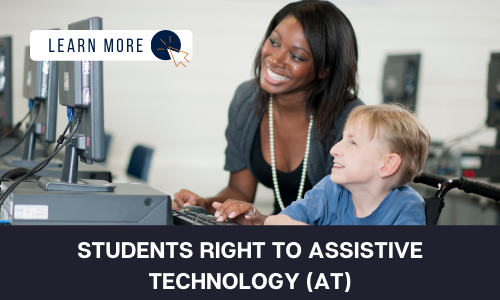Students Right to Assistive Technology (AT)
 |
 |
PDF Version: Students Right to Assistive Technology (AT)
Full Guide of all 30+ Flyers (Compiled as a Booklet)
Versión en Español en Formato PDF: Derecho de los Estudantes a la Tecnologia de Asistencia (AT)
Students with disabilities have a right to any Assistive Technology (AT) device or service necessary for the student to receive a free appropriate public education (FAPE).
The AT must be provided at no cost to the student or parents. Under the Individuals with Disabilities Education Act (IDEA), schools may not charge for special education or related services.
Evaluation for Special Education Services
Eligibility
To receive an AT device or service the student must:
- Need the AT to receive a FAPE.
- Be between birth and 21 years old. Children under the age of 3 may be eligible for AT under the IDEA if the child meets the criteria for early intervention services and the Individual Family Services Program team decides the services are needed. Parents are part of the team.
- Qualify for eligibility under the IDEA categories: Intellectual/Developmental Disability, Deaf/Hard of Hearing, Speech Impairment, Blind/Visually Impaired, Severe Emotional Disturbance, Orthopedic Impairment, Autism, Traumatic Brain Injury, Learning Disability, Other Health Impairment, or Multiple Disabilities.
- Need special education or related services.
AT Device Ownership
Ownership of the AT device is dependent on who paid for the device. When the device is paid for by the school under IDEA, the school owns the device. When the device is paid for by a combination of funds from the school and Medicaid, the student owns the device. If a child/family is of limited income, additional sources of funding for AT can be found under Medicaid's Early and Periodic Screening, Diagnosis and Treatment (EPSDT) program or S-CHIP. In Kansas, these are called KanBe Healthy or HealthWave. When the device is paid for under Medicaid, the student owns the device.
A student may take an AT device home to help with homework, use it for extra-curricular
activities, use with a private tutor, etc. The key is that its use in these settings must be stated in the IEP.
Frequently Asked Questions
Who is responsible for wear and tear and maintenance?
The school is responsible for devices the school owns and purchased for the student's use, per the IEP. The school may be responsible for other AT devices owned by the student, if the IEP team determines that the AT is needed at home in order for the child to receive FAPE.
Can the child take the device to a new school?
If the child is going to a new school in the same district, then they may take the device with them. If the new school is in a different district, they can't take it if the child does not own it. However, the new district must provide any AT device determined to be necessary by the IEP team.
Does this requirement cover transportation needs? What about medical devices?
Transportation needs are covered under this requirement. AT under the IDEA does not include medical devices. This means that for funding of an AT device under the IDEA, the device must have a direct connection to the education of the student.
Sources & Additional Resources:
Parent Guide to Special Education. Kansas State Department of Education.
Parent Guide to Special Education. Families Together, Inc.
Kansas Special Education Process Handbook. Kansas State Department of Education.
What is IDEA? Disability Rights Center of Kansas & Families Together, Inc.
Who can make a referral for an evaluation to determine if my child needs Special Education services? Disability Rights Center of Kansas & Families Together, Inc.
IEP Essentials for Parents. Tourette Syndrome Association, Inc.
Disclaimer: This fact sheet is not intended to provide specific legal advice. If you need legal advice, please contact an attorney. Only an attorney can give you specific legal advice based on your particular situation. We try to update our materials regularly, but the law can change frequently. This publication is based on the law at the time that it was written. Future changes in the law could make information in this fact sheet inaccurate.
.png)





